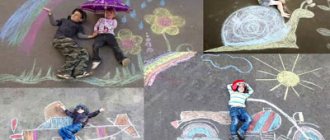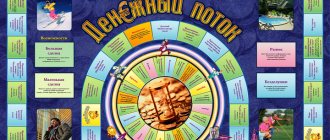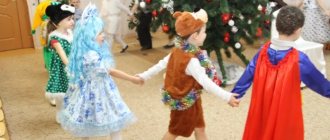Usually, while eating, adults make comments to children, saying, don’t fool around, don’t play with food. But such a game can be useful if it is developmental and educational in nature. We'll tell you what interesting activities with food you can organize for children.
On the one hand, adults' strict approach to food is justified: food is not intended for pampering. It is needed for the body to function properly. On the other hand, children learn about the world, including through play. And play is the main form of their existence. This is not about playing with food on a plate right at the table. There are many other interesting activities with products that we want to introduce you to.
"Cat" in a bag
This fun puzzle game can be played by both children and adults. Joy and fun will be guaranteed to all players.
What you will need : one or two opaque bags or bags, fruits and vegetables (for example, orange, banana, apple, carrots, beets, tomatoes, cucumbers, onions). Choose them depending on the season. Also, for variety, small kitchen utensils can be useful - a vegetable peeler, an egg slicer, a garlic press, etc.
What develops : fine motor skills, logic, associative thinking, spatial imagination, intelligence.
Option 1
Place vegetables, fruits and small kitchen utensils in the bag (it will be more interesting if you select items that differ in shape). Without looking into the bag, the child must put his hand in there, select one of the items and try to guess what is in his hand by touch.
Option 2
Diversify the first version of the game and put identical sets of products in two opaque bags. Having taken out one of them and seeing what he “fished out,” the child must find a “pair” for him in the second bag by touch.
What kind of dish is this?
Participating: guests
Necessary props: ready-made dishes (buckwheat porridge, jellied meat, cottage cheese casserole) or products (beans, rice, sugar, flour poured into saucers).
In the first version of the competition, blindfolded participants try the food offered to them and guess what it is.
Option No. 2 - each player is blindfolded and a saucer with some kind of bulk product is placed in front of him: cereal, sugar, flour. Participants will have to determine by touch what exactly is in the plate.
Picture of pasta, cereals and bulk products
Children love to draw - with their fingers on a foggy window, with chalk on the asphalt, with paints in an album. Drawing expresses connection with the outside world and develops the child’s own perception of reality. You can draw not only with paints or chalk. Pictures can be created from ordinary products that are found in every kitchen.
What you will need : semolina, coarse salt, various cereals (buckwheat, rice, beans, small pasta).
What develops : fine motor skills, perseverance, concentration, imagination, imaginative thinking, sense of beauty. Massages and trains fingers. Has a calming effect.
Option 1
Sprinkle flour, salt or semolina on a smooth surface (this could be a dish, a large plate, a cutting board or a silicone mat for rolling out dough) and invite your child to draw a pattern, geometric shapes or even a small picture with his finger.
Option 2
Pour into different containers and give your child breakfast cereals, cereals, cereals, beans and pasta in different shapes. Apply glue to paper or thick colored cardboard. Ask your child to glue the products together to create a picture. You can do without glue if you simply lay out the sun, house or tree on the table surface. Multi-colored pasta is perfect for this. It's fun to string holey pasta or corn rings onto twine or strong thread to create a necklace.
Sometimes, for fun, you can let your baby play with cooked pasta, spaghetti or noodles. Children love to squeeze them with their hands, watching how the pasta “worms” jump out between their fingers. Oddly enough, this game also develops motor skills, and through this stimulates the areas of the brain that are responsible for motor activity and coordination of movements.
Lobster Festival (Los Angeles, USA)
Not every city can boast that its territory hosts the largest lobster festival in the world. But Los Angeles can, because in 2009 this holiday was included in the Guinness Book of Records as the record holder in the category “Largest number of seafood dishes in an open air.” The heart of the September Lobster Festival is the port of San Pedro, but, oddly enough, lobsters are not caught here - the fresh catch comes from Maine. In addition to delicious and inexpensive lobsters and many other seafood, music and pirate shows, visitors will find the most unexpected entertainment. For example, the “Lobster Parade” is an unforgettable spectacle: happy and proud owners walk down the street in the company of their pets dressed in crustacean costumes, and the spectators squeal with delight and tenderness (one can only sympathize with the dogs).
Lobster Dog Parade Participant
Kitchen "math"
This game will prepare your child for independent cooking. It's no secret how children love to tinker in the kitchen if they are not prohibited from doing so. It is especially inspiring for kids, and even older children, to work with dough, roll it out, cut it out, sculpt figures or decorate products. But we suggest you, while playing with your child, cook borscht, prepare a salad or compote. And not just guided by a recipe that is difficult for a small child to understand, but with the help of simple logic and mathematics.
What you will need : vegetables (for borscht - potatoes, carrots, beets, onions and other products; for salad - tomatoes, cucumbers, sweet peppers, depending on the recipe).
What develops : logical thinking, imagination, mental calculation.
The point of the game is to, together with your child, calculate how much food will be needed to prepare soup or salad. Place in front of your child the pre-washed and peeled vegetables that are needed to prepare borscht, and help him speculatively determine how many vegetables will be needed to make the soup tasty and enough to feed a family of three. In the same way, you can “guess” the amount of ingredients for a salad or compote.
Bocuse d'Or
The Golden Bocuse is the most prestigious and famous professional competition for chefs all over the planet, like the Oscars for filmmakers and the Olympic Games for athletes. It was first held in 1987 on the initiative of the legendary chef Paul Bocuse. The competition involves several stages. First, the participating countries select applicants at the national level, then the Bocuse d'Or Europe, Bocuse d'Or Asia Pacific, Bocuse d'Or Americas and Bocuse d'Or Africa competitions take place. The final stage of the Bocuse d'Or Finale in Lyon determines the absolute winners at the international level - winners of gold, silver and bronze medals.
The laureates of the Bocuse d'Or have attractive professional prospects, and their national cuisine attracts the attention of culinary world experts.
Stamps from vegetables and fruits
Cutting and making stamps from vegetable peels and fruit pulp is a game and fun activity. Even those who do not know how to draw can create their own unique pattern or a whole drawing using such an unusual technique. With the help of such prints you can decorate a tablecloth or bag, create original wrapping paper, design a gift card, or you can label jars of homemade preserves.
What you will need : pieces of potatoes, carrots or pumpkin; onions, cauliflower, celery, citrus fruits give beautiful prints. As well as paint, paper or fabric.
What develops : fine motor skills, coordination of movements, artistic imagination.
It will be easiest for a child to cut out the simplest geometric shapes - a circle, a triangle, a square. Experiment with cookie cutters. Cut a large potato in half lengthwise, cut out a shape from half with a mold and trim off the excess flesh along the contour. Dip the figure in paint and make an imprint on a piece of paper. Using a knife, you can try to cut out more complex irregular shapes - leaves, trees, flowers.
Pancake Race (Olney, London, UK)
Every year on Fat Tuesday, all Londoners are lured outside like a magnet by the smell of freshly baked pancakes, which literally float throughout the city.
No, this is not a mistake and you read everything correctly. One day in 1445, in the town of Olney in southeastern England, one of the church parishioners was baking pancakes on Fat Tuesday, contrary to the rules of fasting. Hearing the bell ringing and coming out of the “pancake trance,” she immediately ran to church to atone for her sins, but it was still not easy for her to part with the pancakes (and she can be understood), so the lady turned the last one right on the go. The people of Olney were so amused by this spectacle that they turned it into a tradition. Today the Pancake Race takes place in both Olney and London. The conditions are as follows: the one who runs the fastest and at the same time turns the pancake in the frying pan the most number of times will receive the bell ringer's kiss. By the way, in Westminster such races are held among members of parliament and lords.
Participants of the Pancake Race
Pass the orange
You can play with fruits not only in board games, but also in outdoor games. They are indispensable to occupy a group of children who are relaxing in nature or gathered for a picnic on the occasion of a birthday.
What you will need : a large orange.
What develops : agility, accuracy, motor activity, coordination of movements.
The more children participate in the game, the more exciting it will be. Children are divided into two teams with the same number of players and lined up (preferably alternating a boy and a girl) opposite each other. The first player in the chain is given an orange and must hold it by pressing his chin to his chest. The team's goal is to pass the orange to each other in a chain from the first to the last player without dropping it. Do not use your hands in this case.
Chocolate Madness
For this competition you will need such props as an apron, a chef's hat, a fork and a real large chocolate bar. All this is placed away from the children who volunteered to take part in the Chocolate Madness. At the leader’s signal, the children take turns throwing the dice. The one who gets a 6 runs to the table with a chocolate bar, puts on a hat and apron, takes a fork and tries to use it to break off a piece of the sweet treat. He does this until the next player rolls a 6 on the dice. The competition continues until the entire chocolate bar is eaten.
Get an apple
During this game, children will enjoy competing with each other in dexterity. Grab your towels, get your stopwatch ready and get started. It will be fun!
What you will need : a wide bowl of water, apples.
What develops : agility, coordination of movements, muscle strength.
Pour water into a bowl or basin and place the apples in it. Children, one at a time, must remove the floating apple from the bowl without using their hands. The one who does it the fastest wins. If you are at the dacha, you can try another version of the game - for example, hanging apples on a cord. Although donuts would be more suitable for this fun competition game!
Gluttons
A fun game that requires a variety of foods (for example, a piece of bread, a slice of lemon, a spoonful of honey, chocolate candy, etc.), as well as a roll of toilet paper. Using a roll of toilet paper, the presenter creates a winding distance (2 pieces in total are needed), where players will encounter various food items on plates. Players start one by one. An important rule is that you can move from one product to the second only after the first has been completely eaten (chewed and swallowed). The glutton who finishes first wins.
"Race" of fruits
You can not only catch fruits in your mouth without using your hands, but also roll them. And not with a foot, not with a hand, but... with a pencil. Well, or with a stick, for example. Give your children such a fun relay race, they will be delighted!
What you will need : apple or orange (potatoes to choose from), pencil.
What develops : agility, concentration, reaction speed, ability to work in a team, sense of competition. The players are divided into two teams. The goal of the game is to roll the fruit with a pencil from the start line to the finish line and in the opposite direction. Then the baton is passed to another player. The team that completes the task first wins. It can be complicated by small obstacles that the fruit needs to “overcome” along the way.
We have collected more interesting outdoor activities with children in a separate material.
- 13 fun things to do outside the city for children and their parents all summer
By summer, quarantine will be lifted, and summer residents, languishing in anticipation, will flock to their garden plots. After all, there will be a lot of things to do! What to do with children at the dacha?
Full and satisfied
The cook has prepared a delicious dish and he can’t wait to serve it to his guest, but unfortunately both have their hands full. A game for two teams, 2 people each. One player is covered with oilcloth and seated on a chair. The second person is given a bowl of jam (pour a little) and a small spoon. The chef's task is to feed his guest without his hands. To do this, you will have to scoop up the jam and pass it to your friend while holding the spoon in your teeth. The winner is the team that “destroys” all the jam faster than the other.
Find the "treasure"
Finding the treasure will turn into a fun game if the treasure is candy, and you need to look for it in the depths of a lush creamy cloud. And again - no hands. Believe me, the fans will roar with laughter!
What you will need : a can of whipped cream (yogurt or cottage cheese), sea pebbles, M&M's, sugar-coated peanuts or chocolate-covered raisins.
What develops : dexterity, coordination of movements, sense of humor.
Place a few jelly beans in a shallow dish. Squeeze whipped cream from the can on top so that it covers the entire candy. The player’s task is to lean over the plate, use his mouth to find candies in the whipped cream foam and eat them. In the process of searching, you will probably have to eat the cream too. And this spectacle is absolutely hilarious! You definitely won’t regret playing this game with your children.
Night of the Radish (Oaxaca, Mexico)
The city of Oaxaca is famous for its woodcarving masters, and on December 23, viewers have a unique opportunity to look at incredible carved radish sculptures. The first festival took place in 1897, but over time the event only gained popularity. During Radish Night, you can see animals, people, various architectural structures, costumes and fruits carved from radishes here. The exhibition features both radish masterpieces by professional woodcarvers and statues made by ordinary fans of this root vegetable.
The city of Oaxaca is the capital of one of the 31 states of Mexico.
La Tomatina (Buñol, Spain)
In the last week of August, tens of thousands of people from all over the world gather in the Spanish town of Buñol to take part in the tomato fight. At this time there are so many tourists that there is not enough accommodation for everyone, so many come from Valencia for the holiday. Before the start of the tomato madness, during which about 145 tons of tomatoes are used, local residents and shop owners cover their windows with plastic shields in order to somehow reduce the area of the upcoming harvest. The central square of the city, Plaza del Pueblo, at 10 am resembles a sleeping volcano, about to wake up and erupt tomato lava. A line of trucks filled with tomatoes drives through the streets and stops in the square. According to the rules, first some daredevil must climb a tall wooden pole greased with soap. At the top, a prize awaits the trickster - jamon. The water cannons then signal for the battle to begin. You can imagine what happens on the streets of Buñol for an hour (that’s how long this chaos lasts), but it’s better to drop everything and go throw tomatoes yourself.
Participants in the battle with tomatoes
Coopershild Cheese Race (Brockworth, England)
On the last Monday in May at 12:00 local time, the annual Cheese Race takes place on Cooper's Hill as part of the Spring Festival. For residents of the village of Brockworth, this event is traditional, and in recent years people from all over the world have come to run for cheese. This custom has been around for hundreds of years; according to one version, people thus confirmed the right to use communal lands for grazing their herds.
So what are the rules? Participants climb to the top of the hill and wait for the signal. Then a wheel of Gloucester cheese is allowed to roll down the hill, after which all participants rush. The one who crosses the finish line first and catches the cheese receives it as a prize. Several ambulances and a rescue team are on duty at the foot of the hill. There were cases when runners received serious injuries: they broke their backs, necks, arms, legs, ribs, and often suffered a concussion. Sometimes, when participants fell, they also injured spectators. Therefore, in recent years, wheels of cheese weighing no more than 5 kilograms have been used for racing.
International Oyster Festival (Galway, Ireland)
In 1954, Brian Collins was thinking about how to make sure his Galway hotel wouldn't be empty in September. The chef of the restaurant located on the hotel's premises gave him a great idea - to add oysters to the menu, the season of which just begins in September. Thus was born the tradition of celebrating the opening of the oyster season. The festival's program of events has expanded over the years, and today at the end of September Galway is packed with locals and tourists slurping down oysters. After presenting the first oyster of the season to the mayor of the city, a colorful carnival procession begins through the streets of the city. To the deafening sounds of music and the clatter of feet dancing fiery Irish dances, people flock to pubs and restaurants to try the freshest and most delicious oysters, sprinkled with lemon juice, and wash them down with the best Guinness. The main part of the festival is the international oyster opening championship. The jury looks not only at the speed of opening and devouring the oysters, but also at the art of removing the meat and the beauty and neatness of eating it.
Galway Oyster Festival
Watermelon Festival (Chinchilla, Australia)
The Australian town of Chinchilla has for several years now held the proud title of the “watermelon” capital of Australia: about a quarter of the country’s total watermelon crop is grown here. Every two years, the city authorities organize the Chinchilla Melon Festival , and the streets of the city are painted a rich red color. The festival welcomes about 15,000 guests, who are invited to take part in the most fun “watermelon” competitions: a competition for the best watermelon helmet, skiing competitions (skis, of course, need to be made from watermelons), throwing watermelons at a target, watermelon basketball and much more. During the festival, more than 20 tons of fruits are destroyed.
Participant of the Watermelon Festival
International Cucumber Festival (Suzdal, Russia)
Every year, during the cucumber harvest period (July-August), Cucumber Day is held on the territory of the Vladimir-Suzdal Museum-Reserve. Suzdal is the capital of this vegetable, so this is where all the “cucumber” fans gather. At the festival you can try the most unexpected dishes with cucumbers: cucumber soup, cucumber jam, pickled, dried, pickled, stuffed cucumbers, pizza with cucumbers and many other dishes. As at any city festival, it’s not complete without fun competitions: a competition for the best cucumber costume, a fight for the title of “The Pickled Cucumber” and “Cucumber Glutton,” as well as a cucumber auction.











